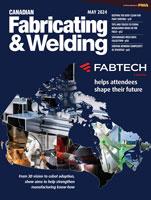Editor
- FMA
- The Fabricator
- FABTECH
- Canadian Metalworking
Innovation push essential for Canada’s manufacturers
As Canada falls behind our neighbours in terms of automation, it's time to think of how to find our way back
- By Rob Colman
- May 2, 2023
We don’t usually write much about the Canadian International AutoShow on our website or in the magazine. As a primarily consumer-oriented event, it’s certainly interesting to see new models and future-focused concepts, but it doesn’t address the back-to-basics needs of you, our readers in the fabricating and welding industry.
This year felt different in some ways. After all, it’s the first such show in Canada since 2020 (the last two were cancelled due to the pandemic) and it’s also the show’s 50th anniversary, which coincides with a significant, full-on push toward electric vehicles.
It seems everyone was more engaged with the show than ever before; it set four daily attendance records, including the largest single-day audience in its history. Associate Editor Lindsay Luminoso was there to witness the new technology and capture images of the excitement on the floor.
She also spoke to a couple experts with sobering views on Canada’s future in automotive who stressed the need for a greater innovation push from all levels of government and industry. Read more of her coverage here.
Innovation isn’t just critical in the automotive sector. The ability to compete effectively demands more investment in automation across the fabricating and forming industry. Industry associations and government are trying to encourage that since Canadian manufacturers seem to continue to fall behind their counterparts south of the border.
To that end, Canadian Manufacturers & Exporters (CME) launched the Technology Investment Program in March to help small- and medium-sized southern Ontario manufacturers compete on the global stage by investing in advanced manufacturing technologies to automate production and reduce their environmental footprint.
Funded by the Government of Canada through the Federal Economic Development Agency for Southern Ontario (FedDev Ontario), the program provides direct financial assistance to eligible manufacturers in the form of a matching contribution of up to $50,000 to support their investment in long-term production assets and technology.
In a press release, CME noted that to compete in the modern economy, manufacturers must be investing in “manufacturing critical technologies” including robotics, artificial intelligence and other machine learning applications, and advanced networks and the Internet of Things.
“When comparing trends in Canada to those south of the border, Ontario manufacturers remain slow adopters of advanced manufacturing technology,” said the statement. “In the U.S. manufacturing sector, machinery and equipment (M&E) investment increased by a total of 34 per cent between 2004 and 2021, but fell by 14.8 per cent in Ontario.”
It can be difficult to take the leap toward a new tech investment. Given the speed at which technology is developing, it can be a challenge to determine where to start with upgrades. But regardless of where you operate in Canada, it’s worth talking to local government to determine what forms of support are available to make that happen.
subscribe now


Keep up to date with the latest news, events, and technology for all things metal from our pair of monthly magazines written specifically for Canadian manufacturers!
Start Your Free SubscriptionAbout the Author

Rob Colman
1154 Warden Avenue
Toronto, M1R 0A1 Canada
905-235-0471
Robert Colman has worked as a writer and editor for more than 25 years, covering the needs of a variety of trades. He has been dedicated to the metalworking industry for the past 13 years, serving as editor for Metalworking Production & Purchasing (MP&P) and, since January 2016, the editor of Canadian Fabricating & Welding. He graduated with a B.A. degree from McGill University and a Master’s degree from UBC.
- Industry Events
Automate 2024
- May 6 - 9, 2024
- Chicago, IL
ANCA Open House
- May 7 - 8, 2024
- Wixom, MI
17th annual Joint Open House
- May 8 - 9, 2024
- Oakville and Mississauga, ON Canada
MME Saskatoon
- May 28, 2024
- Saskatoon, SK Canada
CME's Health & Safety Symposium for Manufacturers
- May 29, 2024
- Mississauga, ON Canada




















